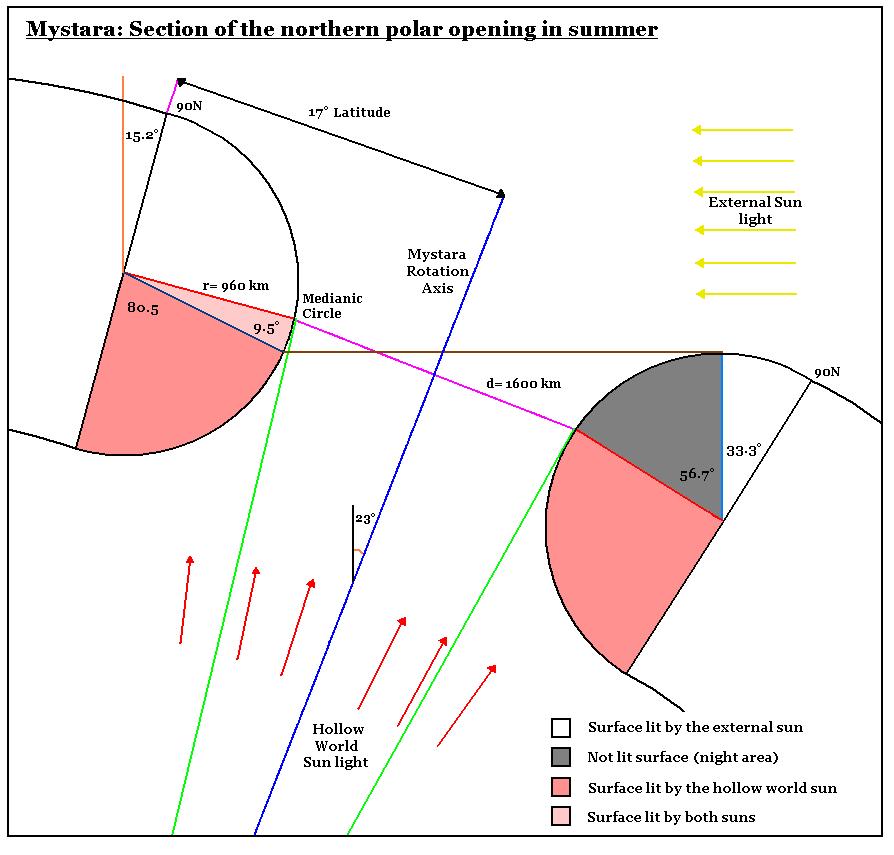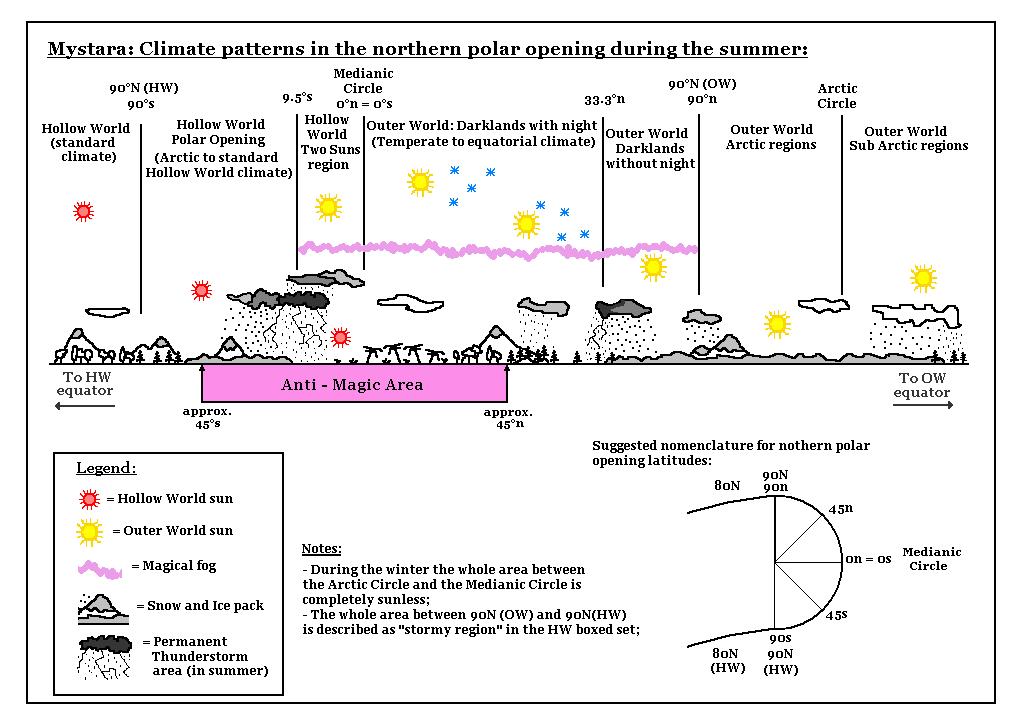
The Climate of the Polar Openings
by LoZompatore.This is a translation of the topic about the polar openings climate we discussed a couple of year ago in the Italian Message Board.
Nothing you will find here come from official supplements, but what the HW designers made (both real world TSR human designers than Mystaran Immortals) might led to the effects speculated below.
Zaryck - a friend of mine in the IMB - noticed that, due to Mystara's axis being tilted with respect to the orbital plane (the same as for Earth), the polar openings are not always in darkness but they should be hit by the external sunlight for 6 months a year, just as the real Earth polar caps.
Now, due to the odd curvature of the polar openings, when the polar cap is lit by sunlight (which means that is summer in the corresponding hemisphere) there are some areas of it where sunrays hit the surface from very high angles - even 90° - so the solar energy receive by these areas is the same as if they were tropical or even equatorial regions.
Remember, in fact, that the main climate pattern from a given area comes from the irradiation it receives from the sun, which depends on the angle the sunrays make with respect to the horizon. If the angle is small the radiation received is equally small, while if the angle is high (up to 90°, corresponding to the perpendicular) the radiation received is at its maximum.
Notice also that Mystara's axis is tilted, otherwise we would not have any season and the climate for a given latitude would be almost the same for the whole year. Let's also assume that the list is 23°, the same as Earth axis: we do not have any info from the official supplements saying something different.
In winter, instead, the whole polar cap lays in the shadow, so the climate of the whole polar opening reverts to typical polar patterns, even in areas who had a tropical/equatorial climate during the summer.
Moreover, due to the axis being tilted, there is a small area of the polar opening where both suns are visible (when the corresponding hemisphere is in summer).
The picture below summarise both phenomena. The scale and the angles of the pictures should be correct. It shows the northern polar opening during the summer solstice (when sunrays hit with a 90° angle the planet's surface corresponding to a latitude of 23°):

Notice a shadowed area in the right of the picture. It is not lit by any of the suns, so it is a "nighttime" region of the polar opening. As you see, it is another effect of Mystara axis being tilted.
As Mystara rotates on its axis on a daily basis, a point in the external polar opening set between the Medianic Circle and an angle of about 56.7° will cross the shadowed area and so it will experience a day and night pattern. The night is shorter near the "latitude" 56.7° and is longest along the Medianic Circle.
This picture represents a polar opening viewed from above. The shadowed area is the dark region that is not lit by both suns. The circle with the "90N" label corresponds to the 90N "latitude" you see in the Hollow World set maps.
Place yourself in the "Darklands with nigh" region and make a circle around the centre of the opening. You'll see that you enter in and exit from the shadowed area, so you experiment a night and a day during a 24 hours cycle.

The so called "Thunderstorm Area" should be a permanent feature that will form during the summer, due to the interaction between the hotter air from the tropical/equatorial regions of the polar opening and the much more cooler air from the rest of the polar cap. We may guess that where these hot and cold weather front meets, very violent storms should happen.
Another "Thunderstorm Area" should be inside the polar nozzle, just "south" of the Medianic Circle in the Hollow World side of the opening. The hotter air from the tropical/equatorial regions of the polar opening meets the cooler air of the Hollow World "polar" region. Notice that, due to the curvature of the polar opening, the HW red sun lights some areas of the polar opening with a very small angle (sunrays are almost parallel to the surface), so these regions are undoubtedly cold, even if magic isn't involved.
The picture below tries to summarise the whole set of different climate patterns for an explorer who wants to travel from the inner side to the outer side of the polar opening (and vice versa).
I included also:
- The anti magic zone extent, from HW maps and info;
- The magical fog extent, from HW page 87; these magical fog-banks cover part of the polar opening, preventing to see the sky and the other side of the opening (so that the explorer cannot realise its true shape and nature);
- The relative height of the suns (both internal and external) at their zenith, so to have an easy way to see if an area is warm (the sun is high) or is cold (the sun is low);
- I added stars in the sky in the regions where there is the "night time" phenomenon explained above;

About the magical fog:
Notice that most of the magical fog area is outside the anti magic area, so a very simple "fly" spell (or a dragon, or an hot-air balloon, etc) would make the whole fog-banks thing useless.
It is also possible that this magical fog is able to darken the land and to reflect most of the heat given by the external sun, thus leading to a cooler climate. Maybe this approach would be useful if someone wants to keep the official info about the polar opening being a very cold and icy and dark area. Anyway, would the fog bank be so thick that an explorer inside it cannot distinguish between day and night? It would be a very thick fog, nevertheless...
Moreover, the whole climate pattern issue is just moved somewhere else. Above the fog banks the climate should be unaltered, so an explorer using a flying mount, a spell, or walking on the top of a mountain chain would experience a lot of changing in temperature and climate from an area to another.
Ekrenor, another IMB member, noticed also that above the fog bank you will be able to see the other side of the polar opening as an impressive arch crossing most of the sky. He speculated about the light reflected by the ice of the polar cap, which would account for a night time lighting many times that of the full moon and that would without doubt represents one of the most beautiful scenery on Mystara.
Remarks:
1) It is easiest to cross the polar opening in winter than in summer. An explorer crossing the opening in winter would experience an uniformly cold weather, the sea are covered with pack and easier to cross, and the whole travel would be similar to what is depicted in the official supplements.
In summer, instead, the set of different climatic patterns represent a major natural barrier. Starting from the outer world polar circle the beleaguered explorer would meet these climatic zones:
polar - ** - temperate and sub-tropical - tropical - equatorial - tropical - ** - polar - temperate
With two asterisks I pointed the likely thunderstorm areas. In summer large water areas should be freed of ice (or maybe they should be covered with icebergs), so the explorers should be prepared to build a ship and try a dangerous crossing by sail.
Even if the temperate/tropical/equatorial area might be friendlier for the explorer, they may present the whole set of dangers typical of these regions which I suppose are unexpected for a polar expedition (did you remember to bring the anti mosquito ointment and the cotton tunic?). Moreover, the explorers might be lured to leave their polar equipment as soon as they cross the first tropical area, without knowing they would need it again as soon as they reach the other polar area ahead. Lastly, if they try to rest too much in the warm region they might be caught by the six month winter, suddenly turning their tropical paradise into a polar landscape.
Crossing in winter is better, in my opinion.
2) This unexpected set of different climatic conditions for 6 months a year provides a lot of opportunities for those who want to insert strange creatures in these already quite odd areas.
It could be possible to insert some kind of "seasonal" ecology, with tropical plants and animals who go through a six months hibernation during winter (or they suddenly adapt to the colder climate by growing heavy furs, changing their shape/colour and making other arrangements) and then flourish again during the summer. Following the Hollow World philosophy, they could be the remaining of habitats created by the Immortals just after the Great Rain of Fire, when the world climate was so unpredictable that there was the need for some very adaptable lifeform in order to feed the starving human and non human civilisations.
Maybe some original culture of this turbulent epoch was preserved here as well.
Moreover, the odd climatic pattern of the polar opening could represent a nice "deus ex machina" while adventuring in the polar region. The PC party is lost in the icy pack, its food stocks at a minimum, they are battered by storms and they don't see 10 foots ahead... and then suddenly the climate becomes warmer, soon they find a boreal wood with game and liquid water and they can have a little rest. By going further ahead the temperature rises, they find a temperate area and they are able to collect fruits and hunt for wild cattle. Maybe they can also find some signs of civilisation, and so on...
In my opinion beastmen, in particular, should like a lot this odd weather pattern.
3) Ekrenor noticed also that the climate differences might not be so extreme as I depicted above, mainly thanks to the strong winds between the inner world and the outer world (these winds are also described in HW and VotPA). The winds should mix the whole atmosphere in the nozzle and its vicinity and, as a result, the climate should be somewhat an average of what I mentioned above. I don't think it would be possible to quantify these effects, but I think they could be taken into account by those who do not want to include micro-climatic areas in the polar openings. In such a picture the whole polar opening crossing should be similar to what is described in the official supplements, even during the summer season.
4) Another possibility to overcome the whole climatic issue would be to say that the polar opening are not aligned with Mystara's axis, but there is an angle of 23° between the axis and the line connecting the polar openings (to justify the pictures in HW and in the PWAs where the polar opening are on the top and on the bottom of the picture, instead of being tilted). In such a way the polar openings are far from the polar caps. Anyway, I don't like this solution because it interferes with existing maps: the polar openings would begin somewhere in northern temperate regions and the local climate should be changed in order to have a polar area around and inside the opening itself.
That's all. Hope it will give you many more adventuring ideas!